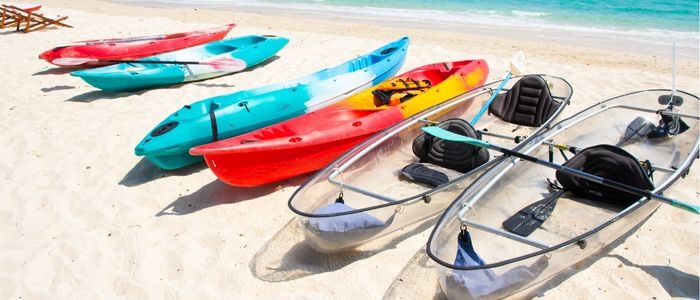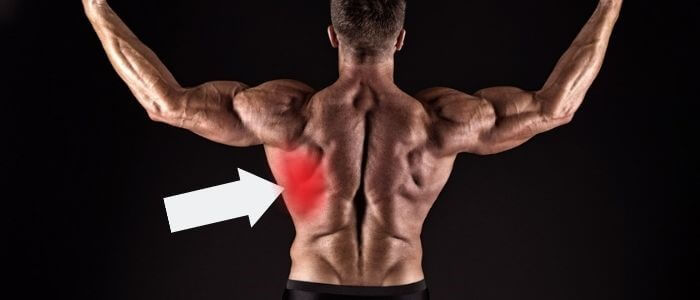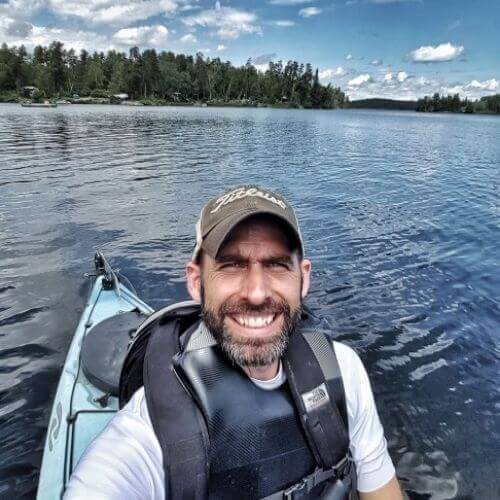
With summer in full swing, kayaking is a popular activity. While it’s a great workout, you may be wondering if kayaking is hard on your back.
If kayaking is not done in a right manner then it might lead to some back pain problems. So you should be aware of the right way of kayaking and also of the factors which can put extra strain on your back while kayaking.
In this blog post, I will break down everything which lead you to be an excellent paddler without facing any injury in the back.
First of all, it is important to know about the common muscles used while Kayaking.

This large, triangular muscle is located on the back side of your upper body, extending from your lower back all the way up to your shoulder.
It’s responsible for both pulling your arm down (as in a rowing motion) and bringing your shoulder blade down and back. When you’re kayaking, this muscle is working overtime to keep you stable and moving forward.
Rhomboids are a group of muscles located in your upper back. They attach your shoulder blades to your spine and help move them towards the center of your back.
While kayaking, your rhomboids work to retract your shoulder blades at the end of each paddle stroke. This action helps stabilize your shoulders and keeps your arms in line with your body.
If you are an avid kayaker, then you know that there are some muscles in your back that help support your shoulders as you move them in the process of Kayaking. These muscles are the upper and lower trapezius muscles.
If these muscles become weak, it can cause pain when paddling or moving your kayaks.
Your abdominal muscles, also called your abs, are the muscles in your belly. They’re responsible for everything from keeping your spine stable to helping your movement in Paddling.
Oblique muscles are a type of abdominal muscle that helps to stabilize and rotate the trunk / torso of the body while Kayaking. The obliques are located on either side of the rectus abdominis (the “six-pack” muscle).
The back pain can be due to a many factors, and it’s important for you to know the reason behind it.
When you are kayaking, you will be sitting in the L-position for long periods of time because you are limited in your movements. This can cause a stiffness and pain in your lower back.
-Change your position often
-Take breaks often
-Stretch your back and legs frequently
-Avoid arching your back while kayaking
-Use a backrest if possible
If you follow these tips, you should be able to avoid back pain while kayaking.
When it comes to kayaking, there are many different ways to prevent the back pain which will help you in the journey of paddling.
You can customize your kayak seat as per your comfort and other parts of the boat to make it more comfortable for your back.
For example, you can add more padding in the seat and backrest area. For achieving this level of comfort, you should buy a kayak seat that fits your body type.
In this seat, you can also add an adjustable backrest to provide more support for your lower back which will help you in the long routes of Kayaking.
With the right setup, kayaking can actually be good for your back! It can strengthens the muscles in your back.
It is important to maintain proper posture while kayaking to prevent back pain. The first thing you should do when sitting in a kayak is put your feet out and straight ahead.
You’ll want to keep them resting on the pegs, with knees slightly bent so that they’re at about an 90 degree angle from one another or more if necessary for comfortability’s sake (depending how tall/lowered someone preference).
Your back should be straight and spine aligned. Imagine there is a string attached to the top of your head gently pulling you upwards. This will help keep your spine in alignment.
Lastly, slightly lean forward so that your weight is evenly distributed across both feet. This will keep you balanced and help prevent fatigue in your back muscles from having to constantly adjust your position.
These tips will provide a stable foundation for your body.
Paddling correctly is key to prevention of back pain while kayaking. The blades of your kayak are designed to cut through water with minimal resistance.
Therefore, it is important to grip your paddle lightly and use a smooth, effortless stroke that allows the blade to do its job. If you grip the paddle too tightly or use too much force, you will quickly tire yourself out and put unnecessary strain on your back.
Carrying the kayak can be difficult and cause back pain if you don’t do it correctly. Kayaks are available in between 20 to 100 pounds. So, choosing the light weight kayak is the best option to prevent spine pain because it’s easy on the body than carrying a heavy kayak.
If you choose to carry heavy kayak then use a kayak carrier or other carrying device designed specifically for kayaks. These devices will help reduce the strain on your back when carrying the kayak.
Stretching before and after kayaking can help prevent back pain. A good stretching routine should include both dynamic and static stretches.
Dynamic stretches are those that involve movement, such as arm swings or leg swings. These stretches help to warm up the muscles and prepare them for activity.
Static stretches are those that are done without movement, such as a standing quad stretch or a chest stretch.
When you are kayaking, it is important to take breaks and change positions often. This will help prevent back pain by giving your muscles a chance to rest.
If you are paddling for an extended period of time, look for opportunities to stop and stretch or take a quick swim. If you are kayaking in a group, take turns leading so that everyone has a chance to take a break.
If you do experience back pain after kayaking, there are things you can do at home to ease the discomfort.
One of the best things you can do is to apply heat to the sore muscles. This can be done with a heating pad, hot water bottle, or even a warm towel.
Another option is to massage the sore muscles. This can be done with your hands, a tennis ball, or a foam roller.
Massaging the muscles will help to increase blood flow and speed up the healing process.
Kayaking can be done in a number of different places, including rivers, lakes, and even the ocean. If you are looking for a place to kayak, there are many resources available that can help you find the perfect spot.
Kayaking is a great way to get exercise and enjoy the outdoors. It is also a low-impact activity, which means it is easy on the joints. In addition, kayaking can help to improve balance and coordination.
It depends on the person. Some people may be able to pick it up quickly, while others may need more time. It is generally recommended that people take a kayaking class or lessons from a qualified instructor before heading out on their own.
The type of paddle you use will depend on the type of kayaking you are doing. For instance, whitewater kayaking generally requires a shorter paddle than sea kayaking. There are also a variety of materials to choose from, including wood, aluminium, and fiberglass.
Overall, kayaking is a low-impact activity that is unlikely to cause back pain. However, there are a few things you can do to prevent back pain while kayaking.
Be sure to use the correct paddling technique, carry your kayak correctly, and stretch before and after your trip. Also, look for opportunities to change positions often.
To treat the sore muscle after kayaking, there are things you can do at home. Apply heat to the sore muscles or massage the area to help speed up the healing process.
By following these tips, you can help prevent back pain while enjoying a day out on the water.

Hey there kayak lovers! I’m Jay Schwartz, the author here at Kayak Guidance! You know water sports – you know me! My life is all about it. Kayaking, Paddleboarding, Fishing, Snorkeling and so much more. I love to share my passion and knowledge with all of you.

Hey there kayak lovers! I’m Jay Schwartz, the author here at Kayak Guidance! You know water sports – you know me! My life is all about it. Kayaking, Paddleboarding, Fishing, Snorkeling and so much more. I love to share my passion and knowledge with all of you.

Welcome to KayakGuidance.com! If you’re looking to have some fun outdoor water adventures, then you have come to the right place. We help our readers find the best kayaks and water related equipment to help you have the best time of your life whenever you are engaging in water activities.
This site is a participant in the Amazon services LLC associates program, an affiliate advertising program designed to provide a means for sites to earn advertising fees by advertising and linking to Amazon.com.